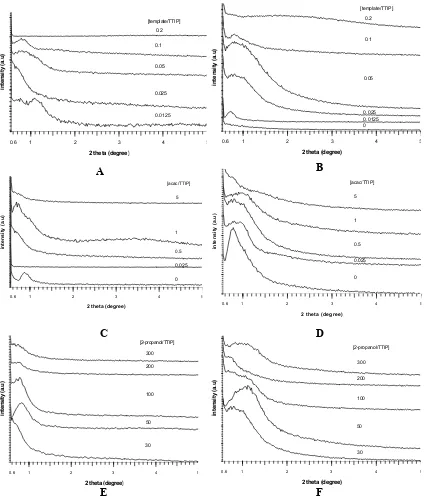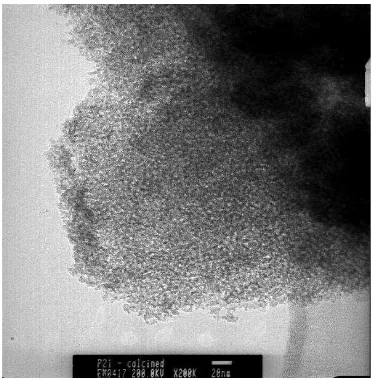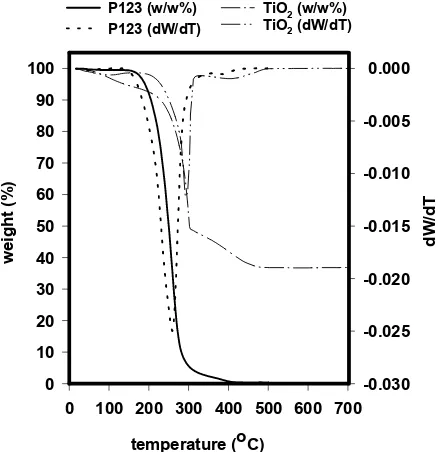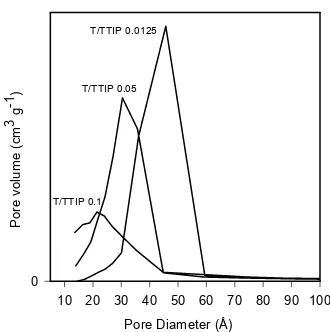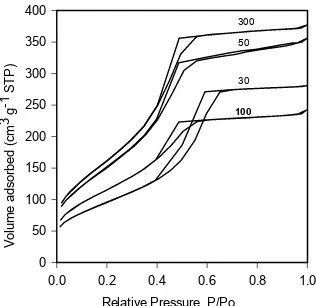Indriana Kartini & Gao Qing Lu
* Corresponding author.
Email address : indriana_kartini@yahoo.com
STUDY OF THE FORMATION OF MESOPOROUS TiO
2USING ISOPROPOXIDE
PRECURSORS UNDER LESS WATER CONDITIONS
Indriana Kartini
a,*and Gao Qing Lu
ba
Chemistry Department, Faculty of Mathematics and Natural Sciences Gadjah Mada University, Yogyakarta, Indonesia 55281
b
ARC Centre for Functional Nanomaterials, School of Engineering, The University of Queensland, St Lucia, QLD 4072, Australia
Received 11 October 2004; Accepted 18 October 2004
ABSTRACT
The role of the synthesis parameters (the molar ratio of template, isopropyl alcohol, acetylacetone, and water with respect to titanium(IV) tetraisopropoxide) has been thoroughly investigated to understand their effects on the mesostructures and the formation of crystalline phases of mesoporous titania xerogels in less water condition (no added water) at 60 oC. The resultant mesoporous titania are more likely to have worm-hole like structure as the dominant stable structure. The template appears to play no significant role in structure directing at mesophase level. However, increasing the amount of the template delays the formation of anatase crystalline phase
Keywords:mesoporous titania, templating synthesis, anatase, evaporation-induced self-assembly
INTRODUCTION
The successful preparation of mesoporous silica by combining sol-gel chemistry with self-assembly of the surfactant moiety continues to inspire work on transition-metal oxides. These materials have potential applications in photocatalysis, energy conversion, sensors, lasers, optoelectronics and photonics. In particular, mesostructured titania [1-14], zirconia [4,11,15-18], and niobia [4,19-21] are very interesting materials which have been extensively explored. In general, mesoporous metal oxides tend to have thermal stability problem. This issue arises from the relatively weak interaction of organic-inorganic moieties [2,3], the higher reactivity of Ti(IV) toward condensation compared to Si(IV) [12,13], incomplete condensation of the walls [5] and the excessive growth of metal polymorphs during heat treatment for surfactant removal [22]. Careful control of the parameters involved in the sol-gel chemistry and the self-assembly process is crucial to overcoming such problems, and hence to achieving high thermal stability of the mesostructure.
A number of researchers have taken advantage of liquid crystalline order in aqueous surfactant systems to synthesise titania with lamellar [5,10,12], cubic [10, 12], and hexagonal
[5,9,10,12] topology. Typically, monomeric species present in the aqueous phase polymerise to form an inorganic mesostructure with shape primarily determined by the organization of the surfactant/water self-assembly. Mostly, these workers used an evaporation-induced self-assembly (EISA) method [1323], a versatile method to prepare mesostructured transition metal oxides films, combined with dip-coating [4,10,12] or spin-coating [9,24] as the deposition techniques onto the substrates.
In this work, we report the importance of controlling the synthesis parameters, in order to obtain stable mesostructures with complimentary discussion on the formation of anatase phase. The composite titania-based materials exhibit bicontinuous wormlike mesophases. The existence of Anatase after heat treatment at low temperature brings the interesting feature of titanium dioxide – block copolymer composite for the use as a wide-band gap semiconductor material.
EXPERIMENTAL SECTION
Sample Preparation
Indriana Kartini & Gao Qing Lu
then added into a clear solution of 3.24 mL of TTIP, 1.1 mL of acetylacetone and 16.7 mL of 2-propanol under vigorous stirring. Drops of HCl (32%, BDH) were subsequently added to adjust the pH of the solution after 2h stirring followed by further stirring for 3h before gelled at 60 oC for 72h. Some variations of the synthesis were designed to obtain the optimum parameters, such as the amount of the template, acetylacetone, isopropyl alcohol, in term of molar ratios with respect to TTIP. The template-to-TTIP molar ratio was varied from 0-0.2. The acetylacetone-to-TTIP molar ratio was varied from 0-5, and the 2-propanol-to-TTIP molar ratio was investigated from 30-300. In all cases one parameter was changed while the others were held constant. Template removal was carried out at 300 oC (heating rate of 1 oC/min) for 4h in a muffle
furnace in air.
Characterisation
The crystal phase of the resultant materials as well as the long-range order of the mesostructure was analysed by wide-angle X-ray diffraction (WA-XRD) and small-angle X-ray diffraction (SA-(WA-XRD), respectively on a parallel-beam optic XRD (Bruker). For the small-angle measurement, detector scans were performed with the angle between the source and the specimen stage set at 0.5o. Evaluation of surface area and pore size distribution was performed at 77K using a Quantachrome instrument, Autosorb-1. The samples were out-gassed overnight at 200 oC under vacuum, prior the measurement. The specific surface area and the pore size distribution were determined by using BET and BJH models for the desorption branch, respectively. TEM analysis was accomplished by using FEI Tecnai-20 200kV TEM. Gel flakes were grinded in acetone, and then a drop was dispersed on a holey Cu carbon grid. TGA analysis was performed to analyse the template removal behavior using a Shimadzu TGA-50 instrument. Samples were loaded on platinum pan, which was heated to 600 oC (heating rate 10 K/min) under airflow of 80 mL/min with nitrogen as the purging gas.
RESULTS AND DISCUSSION
Influence of reactants composition on the formation of Anatase-based meso-structured
titania under anhydrous system at 60 oC
The effect of reactants composition on the formation of mesostructured titania as well as the formation of Anatase phase of titania was investigated in the system of 1TTIP:(0-0.2)P123:(0-28)acac:(28.37-300)propan-2-ol:0.015HCl. Fig. 1
depicts the small-angle diffraction patterns of the as-synthesized and calcined samples prepared at varied molar ratios of template to TTIP, acac to TTIP, and 2-propanol to TTIP. Typically, they had only single broad peak at low angles and slightly shifted to higher angles after calcination. This phenomenon reveals a pore system lacking long-range order and pore shrinkage after thermal treatment, respectively. In general, the peaks are more prominent after calcination, when the template has been burned out leaving opened pores behind. However, an optimum condition on each reactant composition, which is evidenced by the more distinct and intense the peak, was observed. We chosen a system with template-to-TTIP molar ratio of 0.025 – 0.05; acac-to-TTIP molar ratio of 0.025 – 1; and 2-propanol-to-TTIP molar ratio of 50. The right amount of the template used is important for the formation of mesopores. The higher or the lower the amount of template diminished directing effect to the formation of mesopores (Fig. 1A and B). While, under constant template concentration, acetylacetone appeared to have no significant effect in directing the formation of mesopores (Fig. 1C and D). However, increasing the amount of acetylacetone will over-hold titanium isopropoxide back to interact with the template, resulted in poorer mesopore order, as well as observed when raising the amount of 2-propanol in respect to TTIP (Fig. 1E and F). On the other hand, the formation of Anatase phase after calcination at low temperatures is interestingly influenced by the sol composition.
Figure 2 shows the wide-angle XRD patterns of mesostructured titania derived from retarded hydrolysis of titanium tetraisopropoxide (TTIP) under an-hydrous acidic medium at 60 oC for 72h, followed by calcinations at 300 oC for 4h. It can be seen that the titania gels were successfully crystallized to the Anatase phase at relatively low temperature with only a minor brookite peak (noted by asterisk (*) in Fig.3). This results show that even in the anhydrous system, the presence of HCl induces the formation of Anatase phase, as has been observed on hydrous system without the presence of template [25,26]. In this case, the phase formation is greatly affected by the sol composition.
Template Effect
Indriana Kartini & Gao Qing Lu
Fig. 1 Small-angle XRD patterns of mesoporous titania before (A,C,E) and after (B,D,F) calcination
synthesized at different molar ratio of template to TTIP (A,B), acetylacetone(acac) to TTIP (C,D), and 2-propanol to TTIP (E,F).
The primary titania particles were likely covered by the adsorbed block copolymer molecules and retarded from further crystal growth.
TEM image of calcined mesostructured titania prepared at molar ratio of template to TTIP 0.05, acac/TTIP 0.5, and 2-propanol to TTIP 30, is
presented in Fig. 3. It suggests the formation of worm-hole pore type of mesoporous titania and ordered structure with particle size of ~3.8-4 nm. The pore diameter is approximately between 3-3.8 nm. The particles are so overlapping, that causes difficulty to measure the right particle size or pore
Indriana Kartini & Gao Qing Lu
diameter. However, the pore size range is in
accordance with that measured by N2
-adsorption/desorption analysis (Table 1). It can also be observed that the pores arise from interspaces between titania nanocrystallites.
Acetylacetone Effect.
Meanwhile, there is also a limit in the molar ratio of acac to TTIP without significant effect to the
inte
n
s
it
y
(
a
.u
)
2 theta (degree)
20 30 40 50 60 70 80
5
0.025 0.5 1
0 [acac/TTIP]
in
te
n
s
it
y
(
a
.u
)
2 theta (degree)
20 30 40 50 60 70 8
30 50 100 200 300 [2-propanol/TTIP]
Fig. 2 Wide-angle XRD patterns of mesoporous
titania after calcinations at 300 oC for 4h synthesized at different molar ratio of template to TTIP (A), acac to TTIP (B), and 2-propanol to TTIP (C).
formation of Anatase. Increasing the concentration of acetylacetone more than 1 tends to slow down the crystal phase formation. These limitations are in agreement with the limit observed for the formation of mesopore, as also have been observed by Ying and Antonelli [1]. The transparent solution of TTIP was turned yellow soon after the addition of acac. It suggests the formation of Ti-complex that makes the Ti-precursor to be bulkier.
Fig. 3 TEM image of calcined mesostructured titania
prepared at molar ratio of template to TTIP 0.05, 2-propanol to TTIP 300, and acac/TTIP 0.5. Condensation is performed for 72h at 60 oC.
Fig. 4 TEM-image of calcined mesostructured titania
prepared at molar ratio of 2-propanol to TTIP 300, template to TTIP 0.025, and acac/TTIP 0.5. Condensation is performed for 72h at 60 oC.
C
B
A
in
te
n
s
it
y (
a
.u
)
2 theta (degree)
20 30 40 50 60 70 8
0.2
0.1
0.05
0.025
0.0125
0 [template/TTIP]
*
*
Indriana Kartini & Gao Qing Lu
temperature (oC)
0 100 200 300 400 500 600 700 Isopropoxide groups are replaced by acac groups
and Ti(IV) acetylacetonato tris-isopropoxide [25], which has mild reactivity upon hydrolysis, is formed. As a result, excess amount of acac will restrain the interaction between Ti-molecules causing suspension on crystal growth.
2-Propanol Effect
The presence of high amount of alcohol in the sol composition delays the Anatase formation as well. It is likely because of the lack of nuclei resulted from high polarity sols to grow into Anatase crystal phase. Considering polymerization of metal alkoxides [26], instead of formation of oxo-bridges Ti-O-Ti, the condensation stage results in water or alcohol as byproduct. The more alcohol in the system will shift the reaction equilibrium to the breakage of the oxo-bridges. As a consequence, the polymerization is inhibited and the formation of Anatase or other polymorph of titania will be delayed.
TEM-image of calcined mesostructured titania prepared at molar ratio of 2-propanol to TTIP of 300, template to TTIP of 0.025, and acac/TTIP of 0.5, is presented in Fig. 4. It shows the formation of worm-hole pore type of mesoporous titania. The pores are approximately between 4-5 nm diameters and arise from interspaces between titania particles, as observed for calcined sample has been discussed previously (Fig. 3).
Thermal Analysis
Figure 5 shows TGA curves for the thin film prepared at the molar ratio of template to TTIP of 0.05, acac/TTIP of 0.5, and 2-propanol to TTIP of 30 and block copolymer Pluronic P123. The curves
are similar to those previously reported by Yun et al. [9]. The path of weight loss from the as-synthesised film to the final oxide can be divided into 4 steps: below 150 oC, 150-300 oC, 300-450 oC, and above 450 oC. These can be described as follows: below 150 oC, the percent mass loss is due to the release of volatile matters, such as 2-propanol, water, and or HCl. Then from 150-300 oC, the loss is associated with evolution process of the block copolymer template accompanied with further discharge of water, HCl, and possible organochlor compounds [2].
Fig. 5 TG-DTA curves of titania thin films (dashed
lines) and pure Pluronic P123 (solid lines)
Table 1 Properties of calcined mesostructured titania obtained under anhydrous at 60 oC
Condition* (molar ratio) Pore diameter (Å) SBET (m2/g) Total pore volume (cc/g)
Indriana Kartini & Gao Qing Lu
Fig. 6 N2 adsorption-desorption isotherms of
calcined samples prepared at various molar ratio of template to TTIP (T/TTIP)
Fig. 7 Pore size distribution of calcined samples
prepared at various molar ratio of template to TTIP (T/TTIP)
While from 300-450 oC, further oxidation of the organic backbone of the template and acetylacetone occured. Initial growth of Anatase phase is also possible in this region, as has been proven by wide-angle XRD pattern for calcined samples. Complete water loss followed by extended crystallization of Anatase will be responsible to the weight loss above 450 oC.
Textural properties of mesostructured titania
synthesized in anhydrous system at 60 oC
Calcination of titania samples in air leads to high surface area titania, resulting in mean pores size in the range of mesoporosity [27]. Table 1 summarizes the effect of sol composition on the BET-surface area and porosity of the resultant gels.
Template Effect
Fig. 6 illustrates the N2 adsorption-desorption isotherms for calcined mesostructured titania with varied template to TTIP molar ratios. The isotherms are of type IV, characteristics of mesoporous materials with different types of hysteresis loop, indicating different shape of pores. Samples prepared at T/TTIP 0.025 and 0.05 showed intermediate type of H2-H1 hysteresis loops [27] with inflection points at P/Po ~ 0.4. Desorption and adsorption branches are slooping nearly parallel over an appreciable gas uptake identifying narrow pore size distribution (Fig. 7), while H2 type is
typical for wormhole structured material [13]. At higher amount of template, the isotherm tends to resemble that of microporous materials, a combination of type I and IV. Similar results have also been observed by Soller-Illia et al. [13] for calcined titania at high temperatures. However, there is no observed macroporosity. Partial blocking of the channels due to residual carbonaceous material is likely to be the reason, therefore reduced pore size and hindered capillary condensation are both observed. In this case, high surface area was contributed by both mesopores and micropores. The presence of microporosity is more prominent with the sample obtained using T/TTIP 0.2, indicated by the presence of low-pressure hysteresis (isotherm not shown).
Acetylacetone and 2-Propanol Effects
Indriana Kartini & Gao Qing Lu
Fig. 8. N2 adsorption-desorption isotherms of
calcined samples prepared at various molar ratio of acetylacetone to TTIP
Fig. 9. N2 adsorption-desorption isotherms of
calcined samples prepared at various molar ratio of 2-propanol to TTIP
CONCLUSION
It has been shown that in the anhydrous system, rapid condensation (performed at 60 oC) leads to the formation of mesostructured titania with worm-hole like pore structure. On the other hand, high amount of template retards the formation of Anatase polymorph of titanium dioxide, so does alcohol. Therefore, careful choice of parameters involved during preparation of titanium-based thin films is important to obtain high degree mesophases organization with reasonable Anatase crystallinity. Current research focused on the effect of different titanium precursors as well as the pH of the system to the formation of well-defined mesostructured TiO2-based thin films with Anatase domains. These mesostructured titania-based thin films of high surface area Anatase and better ordered mesophases present unique characteristics useful towards a wide-band gap semiconductor material application.
ACKNOWLEDGEMENTS
IK gratefully acknowledged financial supports from QUE-Project CSP Gadjah Mada University (Indonesia) and the ARC Australia.
REFERENCES
1. Antonelli, D. M. and Ying, J. Y., Angew. Chem., Int. Engl. Ed., 1995, 34, 2014.
2. Froba, M., Muth, O., and Reller, A., Solid State Ion., 1997, 101-103, 249.
3. Antonelli, D. M., Microporous Mesoporous Mater., 1999, 30, 315.
7. Blanchard, J., Schuth, F., Trens, P., and Hudson, M. Microporous Mesoporous Mater., 2000, 39, 163.
10. Grosso, D., Soler-Illia, G., Babonneau, F., Sanchez, C., Albouy, P. A., Brunet-Bruneau, A., and Balkenende, A. R., Adv. Mater. , 2001, 13, 1085.
11. Crepaldi, E. L., Soler-Illia, G. J. de. A. A., Grosso, D., Albouy, P.-A., Amenitsch, H.,, and Sanchez, C. Stud. Surf. Sci. Catal., 2002, 141, 14. Sanchez, C., Crepaldi, E. L., Bouchara, A.,
Indriana Kartini & Gao Qing Lu
15. Wong, M. S. and Ying, J. Y. Chem. Mater. , 1998, 10, 2067.
16. Ciesla, U., Stucky, G., and Schuth, F. Stud. Surf. Sci. Catal., 1998, 117, 527.
17. Ciesla, U., Froba, M., Stucky, G., and Schuth, F. Chem. Mater., 1999, 11, 227.
18. Blin, J. L., Flamant, R., and Su, B. L. Int. J. Inorg. Mater., 2001, 3, 959.
19. Antonelli, D. M., Nakahira, A., and Ying, J. Y. Inorg. Chem., 1996, 35, 3126.
20. Vettraino, M., He, X., Trudeau, M., and Antonelli, D. M. J. Mater. Chem., 2001, 11, 1755.
21. Mal, N. K., Fujiwara, M., Ichikawa, S., and Kuraoka, K. J. Ceram. Soc. Jpn., 2002, 110, 890.
22. Ni, B. A., Chen, H. Y., Chen, J. S., Liu, Y. L., Guo, Y. H., Li, D. M., and Pang, W. Q. Mater., Mater. Lett., 2002, 52, 24.
23. Brinker, C. J., Lu, Y., Sellinger, A., and Fan, H. Adv. Mater., 1999, 11, 579.
24. Vogel, R., Meredith, P., Kartini, I., Harvey, M., Riches, J. D., Bishop, A., Heckenberg, N., Trau, M., and Rubinsztein-Dunlop, H., Chem. Phys. Chem., 2003, 4, 595.
25. Wang, C.-C, and Ying, J. Y. Chem. Mater. , 1999, 11, 3113.
26. Song, K. C. and Pratsinis, S. E. J. Am. Ceram. Soc. , 2001, 84, 92.
